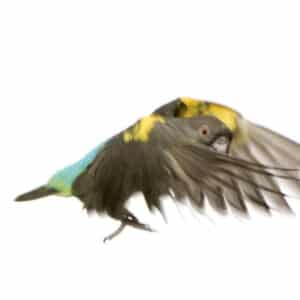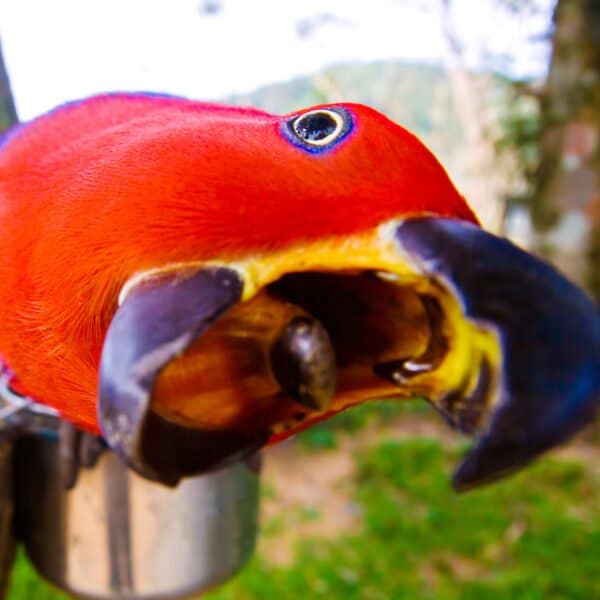
How Do I Transition 8 Amazons and 2 Macaws to a Large Aviary?
Last Updated on by Mitch Rezman
Barb H. asks:
I’d appreciate advice on integrating parrots into a 36′ X 10 communal aviary for 8 amazons & 2 macaws.
These birds have all lived together in the same room divided by partitions. Although separated, they can see each other and communicate.
Since they’re familiar with each other, I’m hoping for a painless transition.
After I partition Amazons from Macaws do you think I can safely release all the Amazons into the enclosure together?
Hi Barb,
What do webmasters, data scientists, and multiple pet bird keepers have in common?
They must test for everything.
I’d worry less about the separation of species and more about who the boys and the girls are defining potential jealousies.
The video below is interesting on many levels.
I posted the video here to illustrate macaws and Amazon’s all getting along while focused on foraging for clay.
BTW – it has been accepted that the clay is used to reduce toxins in a bird’s digestive system
Destin, a thermal physics engineer explains in another video that the real reason the birds are eating clay as for the salt
There are two primary strategies to develop.
3 to 4 feeding/watering stations so one bird can not block another from a single feeder.
Privacy safety zones.
Large toys, accessories, and even plants where a parrot can feel safe.
One of the positive things you have going here is they are all from the same continent.
We have an African ringneck, a South American Quaker, and an Australian budgie, who are all just now getting to know each other after about 4 months of cohabitation.
Our 3 new roomies
You don’t mention if your birds are flighted or clipped.
In an aviary, that size, being flighted is helpful for escape (from another bird) reasons.
We advocate keeping birds flighted what but when we bring a new one into the home we clip their wings until they begin to learn “landing zones”
In the video (above), the birds are out of their cages
This my home office so they are out and un-partitioned for up to 12 hours a day.
Everything is fine until one bird gets closer to another.
If Barney the cockatiel flies to Keto’s cage, Keto will try to bite Barney’s feet from the inside.
If Barney flies to Chili’s cage (the Quaker), Chili will bark at him like a dog (or seal, we’re not sure) and shoos him off HIS cage.
I advocate that you introduce the birds into the new aviary one at a time over 2 to 3 days for each bird and watch for issues.
We also preach about having full-spectrum lighting over every occasion aviary using timers for 12 hours on 12 hours off.
In your case, I would make sure that you have enough “nightlights” to ensure visibility after the sun goes down.
This way birds aren’t bumping into each other in the middle of the night causing unwanted reactions.
Nighttime can bring the biggest problems like a startled bird biting off another bird’s toe.
You’ll want to ensure that everyone has their favorite toy or toy type much like kids at a playground.
Unpredictability is the biggest problem because of instinctual expectations.
That said, providing the ability to fly 36 feet in a single direction is very healthy and will reduce negative hormonal activities and make for confidence birds.
Feel free to reach out with any more questions.
We love to see a video of this spectacular transition.
Stay safe
Best
MitchR
Author Profile
Latest entries
 The Traveling BirdJune 26, 2025Can You Name 5 Parrot Species That Are Living Wild in the USA?
The Traveling BirdJune 26, 2025Can You Name 5 Parrot Species That Are Living Wild in the USA? Bird BehaviorJune 26, 2025How is it Parrots Are Problem Solvers Social Animals and Even Use Tools?
Bird BehaviorJune 26, 2025How is it Parrots Are Problem Solvers Social Animals and Even Use Tools? Bird & Parrot AnatomyJune 25, 2025How a Tiny Chemical Modification Makes Parrots Nature’s Living Paintings
Bird & Parrot AnatomyJune 25, 2025How a Tiny Chemical Modification Makes Parrots Nature’s Living Paintings PigeonsJune 20, 2025How Do Parrots Thrive in Cities Outside Their Native Habitats?
PigeonsJune 20, 2025How Do Parrots Thrive in Cities Outside Their Native Habitats?


